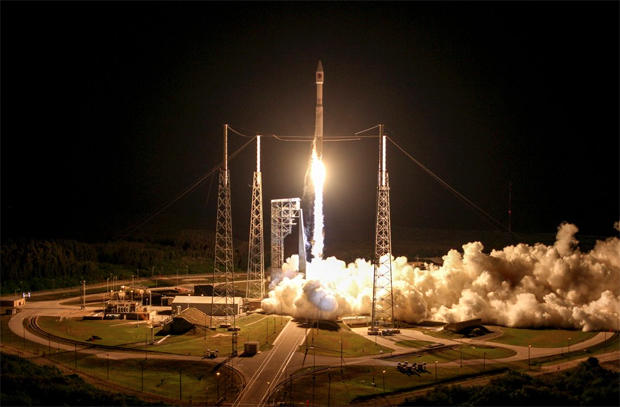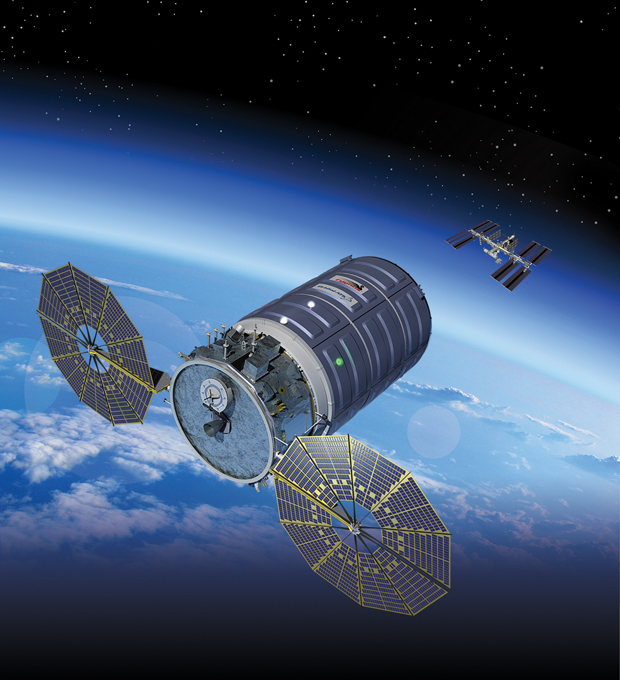Space station cargo ship carries cool science experiments into orbit
An Orbital ATK cargo ship loaded with more than 7,200 pounds of space station-bound equipment and supplies -- including research to learn more about fires in space and gecko-inspired adhesives -- was boosted into orbit late Tuesday, the second of a record four flights to the lab complex in just three weeks.
With a full moon and Jupiter shining overhead, the United Launch Alliance Atlas 5 rocket carrying the Cygnus cargo ship thundered to life at 11:05:52 p.m. EDT (GMT-5), lighting up the night sky with a rush of fiery exhaust from its Russian-built RD-180 first-stage engine.
Putting on a spectacular show as it climbed above the Cape Canaveral Air Force Station, the 194-foot-tall Atlas 5 arced away to the northeast atop 860,000 pounds of thrust, smoothly accelerating as it burned up its first-stage load of liquid oxygen and RP-1 rocket fuel.
At the moment of liftoff, the International Space Station was passing north of the Bahamas a few hundred miles to the southeast, but it wasn't immediately known if any of the lab's six-man crew was able to see the Atlas' climb to space.
In any case, the RD-180 shut down as planned four minutes and 15 seconds after liftoff and the spent stage fell away. Seconds later, the single Aerojet Rocketdyne RL10C engine powering the booster's second stage ignited to continue the climb to space.
After a slightly longer-than-expected 14-minute "burn," the engine shut down and three minutes after that, the Cygnus spacecraft, named in honor of Rick Husband, commander of the ill-fated shuttle Columbia, was released in a roughly circular 143-mile-high orbit
If all goes well, the cargo ship will catch up with the station early Saturday, pulling up to within about 30 feet and then standing by while Expedition 47 commander Timothy Kopra, operating the station's robot arm, locks onto a grapple fixture.
From there, flight controllers in Houston, operating the arm remotely, will pull the Cygnus in for berthing at the Earth-facing port of the station's central Unity module.
The Cygnus, making Orbital ATK's fifth operational station resupply flight -- its second since a catastrophic October 2014 launch failure -- is loaded with 1,713 pounds of science gear, 2,511 pounds of crew supplies, 2,442 pounds of station hardware and another 550 pounds of computer and spacewalk equipment.
Science experiments
The gear includes 29 small "nano" satellites, a 3D printer and experiments in a variety of fields, including one to study mechanical "grippers" that work on the same principal as a gecko's sticky feet; another to spectroscopically study meteor trails from above to determine their chemical constituents; and one to learn more about how the soil of airless moons, comets and asteroids behaves.
"There's evidence to suggest these things tend to shift and move and flow, kind of like a gravel bar or sand bar in a stream, and this material moves over time. We don't know exactly how or to what extent that happens," said Marc Fries, principal investigator Strata-1 experiment.
"We don't know the extent of the hazards an astronaut would face trying to move materials under those conditions. It's a very practical problem in that extent. If you go up to an asteroid and you set an anchor in, is your anchor going to hold? Or are you just going to pull a bunch of material free when you tug on the anchor? That's the long and short of it."
Glass beads in various sizes, simulating samples of regolith, or soil, will be released into tubes and then monitored by video cameras aboard the station to study how the particles shift and move about in microgravity. One sample is made up of particles from a meteorite found in north Africa.
"It was a fairly large rock that we broke up into fragments and then size sorted the fragments," said Fries. "I'd like to say no meteorites were harmed in the making of this experiment, but yeah, we beat it with a hammer pretty well."
Fire experiment
In another experiment that could play a major role improving flight safety on future spacecraft, engineers plan to set a large-scale fire in an experiment housing aboard the Cygnus after the cargo ship leaves the station in late May.
The goal is "to answer the questions of how large does a fire get and how rapidly does it spread, or how long does it take it to get to the point where it would be really hazardous to the crew?" said NASA co-investigator Gary Ruff.
"The other goal is to look at material flammability limits, and that is going to answer the question will a material burn better or extinguish in microgravity compared to how it behaves when we perform a similar test on the ground?"
While the physics of flames in microgravity has been studied for years, this will be the largest fire ever deliberately set in space, using a composite fiberglass-cotton fabric sample measuring 3.2 feet long by 16 inches wide. Cameras will record the fire and sensors will measure temperature and other factors. The video and data will be downlinked before the Cygnus plunges back into the atmosphere eight days after leaving the station.
"One of the big questions in fire safety is how rapidly do conditions in a room or spacecraft get bad for inhabitants?" Ruff said. "Based on that answer, what we can do is make sure we provide the right types of fire detection, fire suppression, clean up equipment and fire protection for the crew while they are responding to a fire."
"Gecko grippers"
As for the "gecko grippers," researchers will be testing adhesive pads designed to take advantage of the subtle molecular forces utilized by gecko lizards to climb and cling to vertical surfaces. The goal is to develop adhesive technology that can be turned on and off, used repeatedly, leaves no residue and is immune to temperature extremes and vacuum.
"Geckos have lots of tiny hairs on their feet that help them to stick to things using Van der Waals force," said Aaron Parness, the principal investigator, referring to molecular forces that cause atoms and molecules to be attracted to those making up a surface.
While researchers cannot yet reproduce the ultra-fine hairs, or setae, on a gecko's feet, they have come up with a material that, when pressed in place, allows those same molecular forces to hold the pad in place. By pushing on the material, the tips of the simulated hairs can be shifted, increasing or decreasing the area in contact with the surface. This, in effect, turns the adhesive effect on and off.
Parness said gecko grippers could be used to mount sensors on a spacecraft "to check the structural integrity of objects or look for micrometeorite impacts" or even used in robots that could crawl about the hull of a spacecraft, using the adhesive technology to "stick" to the surface.
"While we're specifically interested in space applications, gecko adhesives could one day make their way into your home," he said. "One can imagine hanging pictures or flat screen TVs on the wall without having to drill into your wall and when you want to move houses, you simply unstick the adhesive and put it somewhere else."
Flurry of launches
The Atlas 5/Cygnus launch campaign came just a few days after a Russian Soyuz spacecraft delivered three fresh crew members to the space station last Friday. It was Orbital's second use of an Atlas 5 amid ongoing work to recover from the November 2014 failure of an Orbital Antares booster due to an engine failure. The company has redesigned the Antares to work with different engines and launches are expected to resume this summer.
Next Thursday, just five days after the Cygnus is berthed at the station, a Russian Progress supply ship is scheduled for launch from the Baikonur Cosmodrome in Kazakhstan to deliver another 3 tons of cargo, supplies and propellant, docking April 2 at the aft port of the Zvezda command module.
Six days after that, on April 8, SpaceX hopes to launch one of its Dragon cargo ships loaded with another 7,200 pounds of supplies and equipment. It will be the first launch of a Dragon since a catastrophic launch failure last June. The Dragon will be berthed at the Earth-facing port of the station's forward Harmony module.
The delivery of a combined 12 tons of cargo and supplies will further boost the station's on-board supplies, or "consumables," extending margins through the end of the year and into 2017 as NASA continues its effort to recover from the 2014 Antares failure and the subsequent losses of a Progress and a Dragon last April and June respectively.
Kenny Todd, director of space station integration and operations at the Johnson Space Center in Houston, said the lab's reserves are nearly back to the desired levels with five successful resupply flights in a row going into the Cygnus launch campaign.
"At the end of the day, these resupply missions are critical, they've kind of become our lifeblood on space station," he said. "The ISS is in really good shape consumables wise, we're in very, very good shape."



